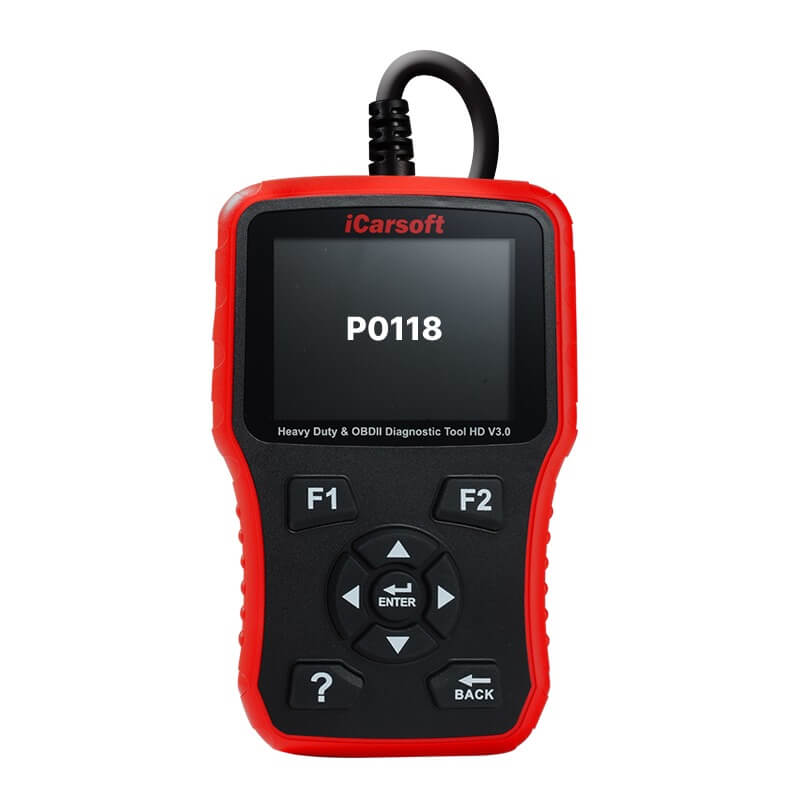P0118 – Engine Coolant Temperature Sensor Circuit High
POSTED IN pcodes
Welcome to our article on the P0118 code, which refers to the engine coolant temperature sensor circuit registering a high input. If you’re experiencing issues related to temperature sensor circuit high, engine coolant temperature sensor, or the P0118 code itself, you’re in the right place. In this article, we will provide a technical description of the code, its meaning, severity, symptoms, common causes, troubleshooting steps, and potential repair solutions. By the end of this article, you’ll have a better understanding of how to diagnose and fix the P0118 code.
Key Takeaways:
- The P0118 code indicates a high input from the engine coolant temperature sensor circuit.
- Symptoms of the P0118 code include poor fuel economy, a no start condition, rough running, and the illumination of the MIL.
- Common causes of the code include a bad connection at the sensor, an open or short in the ground or voltage circuit, a bad PCM, or a faulty temperature sensor.
- Troubleshooting steps involve checking the coolant sensor reading, performing a “wiggle” test on the sensor connector and harness, and checking for 5 volts reference voltage and ground presence at the connector.
- If necessary, the temperature sensor can be replaced or the wiring and PCM can be repaired.
What is the Meaning and Severity of the P0118 Code?
The P0118 code refers to the engine coolant temperature sensor circuit registering a high input voltage. This means that there is an issue with the engine coolant temperature sensor, the wiring or connectors associated with it, or the engine control module (PCM).
The severity of the P0118 code can vary depending on the symptoms experienced. If the engine is running smoothly without any noticeable problems, the severity may be considered low. However, if the code is causing issues such as poor fuel economy, difficulty starting the engine, rough running, or other significant problems, the severity may be higher.
Addressing the P0118 code as soon as possible is recommended to avoid potential damage to the engine or other components. Ignoring the code could lead to further complications and more expensive repairs down the line.
“Addressing the P0118 code as soon as possible is recommended to avoid potential damage to the engine or other components.”
Buy tested tuning file for Adblue / EGR / DPF / Adblue off now!
Register Now or Already have an account, Login now
Symptoms of a P0118 Code
If your vehicle is experiencing a P0118 code, it is important to be aware of the following symptoms:
- Very poor fuel economy: The engine coolant temperature sensor circuit high can cause your vehicle to consume more fuel than usual, resulting in decreased fuel efficiency.
- No start condition: The P0118 code may prevent your vehicle from starting, leaving you stranded and unable to use your vehicle.
- Running poorly with black smoke and misfires: A malfunctioning engine coolant temperature sensor circuit can cause your engine to run rough, emitting black smoke from the exhaust and experiencing misfires.
- Illumination of the check engine light: When the P0118 code is triggered, the check engine light on your dashboard will illuminate, indicating a problem that needs to be addressed.
These symptoms may vary depending on the specific vehicle and the extent of the issue. It is important to address these symptoms promptly to prevent further damage to the engine or other components.

Common Causes of the P0118 Code
When diagnosing and repairing the P0118 code, it is important to identify the common causes that can trigger this issue. Understanding these causes will help pinpoint and address the underlying problem effectively.
Below are the most common causes of the P0118 code:
- A bad connection at the temperature sensor
- An open in the ground circuit between the ECT sensor and the PCM
- A short in the voltage feed between the sensor and the PCM
- A bad PCM (less likely)
- A bad temperature sensor (shorted internally)
These causes can result in an inaccurate reading from the temperature sensor, which leads to a high voltage input and triggers the P0118 code. When troubleshooting the code, it is crucial to inspect these potential causes and address them accordingly.
If you suspect any of these common causes, it is advisable to consult a professional or a qualified technician who can accurately diagnose and repair the issue. They have the expertise and tools to identify the root cause and implement the necessary repairs or replacements.
By addressing the common causes of the P0118 code, you can resolve the underlying problem and ensure optimal performance of your vehicle.
Troubleshooting Steps for the P0118 Code
When troubleshooting the P0118 code, there are several steps you can follow to identify and resolve the issue. Start by using a scan tool to check the reading of the coolant sensor. If the reading appears logical, you can proceed to the next step. However, if the reading seems illogical or doesn’t make sense, there may be an underlying problem.
Perform a “wiggle” test on the connector and harness while monitoring the scan tool reading. Look for any drop-outs or fluctuations in the reading, as this can indicate a bad connection. If you notice any inconsistencies, it’s important to address the issue by inspecting the connector and harness for any damage or corrosion. Repair or replace any damaged components as necessary to ensure a secure connection.
Next, check the resistance of the temperature sensor. If the resistance is out of specifications, it’s recommended to replace the sensor. On the other hand, if the resistance is within the specified range, unplug the sensor and jumper the two terminals of the connector together with a fused jumper wire.
With the jumper wire in place, observe the temperature reading on the scan tool. The reading should max out above 250 degrees F. If it doesn’t reach this temperature, there may be an issue with the ground circuit or voltage supply. It’s important to check for 5 volts reference voltage and ground presence at the connector and diagnose any problems found.
If necessary, you may need to repair or replace the wiring or the powertrain control module (PCM). Be thorough in your troubleshooting process to ensure accurate diagnosis and effective resolution of the P0118 code.

Following these troubleshooting steps for the P0118 code can help you identify and resolve the underlying issue. By using a scan tool, performing a “wiggle” test, checking the resistance of the temperature sensor, and diagnosing any problems with the voltage supply and ground circuit, you can effectively troubleshoot and repair the P0118 code.
Potential Solutions for the P0118 Code
When faced with a P0118 code, there are several potential solutions you can try to resolve the issue. These solutions will help diagnose and address the underlying cause of the code, allowing your vehicle to function optimally once again.
- Check for related DTCs: Start by checking for any related Diagnostic Trouble Codes (DTCs) using a scan tool. This will provide valuable information that can help identify the specific fault.
- Review freeze frame data: Take a look at the freeze frame data captured by the vehicle’s onboard computer system. Analyzing this information can provide insights into the conditions under which the code was triggered, helping you pinpoint the potential cause.
- Inspect wires and connectors: Thoroughly inspect the wires and connectors associated with the engine coolant temperature sensor circuit. Look for signs of damage, corrosion, or loose connections. Repair or replace any components as necessary to ensure proper functionality.
- Check coolant levels and quality: Ensure that your coolant levels are sufficient and that there are no air pockets in the system. Additionally, check for any signs of coolant contamination. Correcting these issues can help prevent inaccurate readings from the temperature sensor.
- Measure resistance of the ECT circuit: Use a multimeter to measure the resistance of the engine coolant temperature (ECT) circuit. Compare the readings to the manufacturer’s specifications. If the readings are abnormal or out of range, consider replacing the sensor to restore proper operation.
- Consider PCM replacement: If all other troubleshooting steps have been exhausted and the issue persists, it may be necessary to replace the engine control module (PCM). This should only be done after thorough diagnosis and confirmation that the PCM is indeed the root cause of the problem.
- Seek professional assistance: If you’re unsure or uncomfortable performing the diagnosis and repairs yourself, it’s always best to seek help from a qualified automotive technician. They have the experience, tools, and knowledge to efficiently diagnose and resolve the P0118 code.
By following these potential solutions and addressing the underlying issues, you can effectively resolve the P0118 code and ensure the proper functioning of your vehicle’s engine coolant temperature sensor circuit.
Conclusion
In conclusion, diagnosing and fixing the P0118 – Engine Coolant Temperature Sensor Circuit High code is crucial for the proper functioning of your engine and vehicle. While it can be a challenging task, it is essential to address this issue promptly to prevent further damage and ensure optimal performance.
If you are unable to seek professional assistance, there is an alternative solution available. You can consider the permanent removal of this specific Pcode. This can be accomplished by uploading the Engine Control Unit (ECU) file to a specialized portal. By removing the code from the ECU, you can potentially eliminate the issue and improve your vehicle’s performance.
Remember, whether you choose to seek professional help or opt for the permanent removal of the P0118 code, it is crucial to take action. Ignoring the code can lead to potential complications and further damage to your engine. So, prioritize the diagnosis and resolution of the P0118 code to ensure the longevity and reliability of your vehicle.
FAQ
What does the P0118 code mean?
The P0118 code refers to the engine coolant temperature sensor circuit registering a high input voltage. This indicates a problem with the sensor or the circuit.
How severe is the P0118 code?
The severity of the P0118 code can vary. It may be low if there are no noticeable issues, but it can be higher if it is causing significant problems such as poor fuel economy or difficulty starting the engine.
What are the symptoms of a P0118 code?
Symptoms of a P0118 code may include poor fuel economy, a no start condition, rough running, and the illumination of the check engine light.
What are the common causes of a P0118 code?
Common causes of a P0118 code include a bad connection at the sensor, an open or short in the ground circuit, a short in the voltage feed, a bad PCM, or a bad temperature sensor.
What are the troubleshooting steps for a P0118 code?
Troubleshooting steps for a P0118 code involve checking the coolant sensor reading with a scan tool, performing a “wiggle” test on the sensor connector and harness, checking the resistance of the temperature sensor, and checking for 5 volts reference voltage and ground presence at the connector.
What are the potential solutions for a P0118 code?
Potential solutions for a P0118 code include checking for related DTCs, inspecting the wires and connectors for damage, ensuring proper coolant levels, measuring the resistance of the ECT circuit, and replacing the sensor or the PCM if necessary.
Is it possible to permanently remove the P0118 code?
Yes, it is possible to permanently remove the P0118 code by uploading the Engine Control Unit (ECU) file to a specialized portal. However, it is important to address the underlying issue to ensure optimal vehicle performance.


